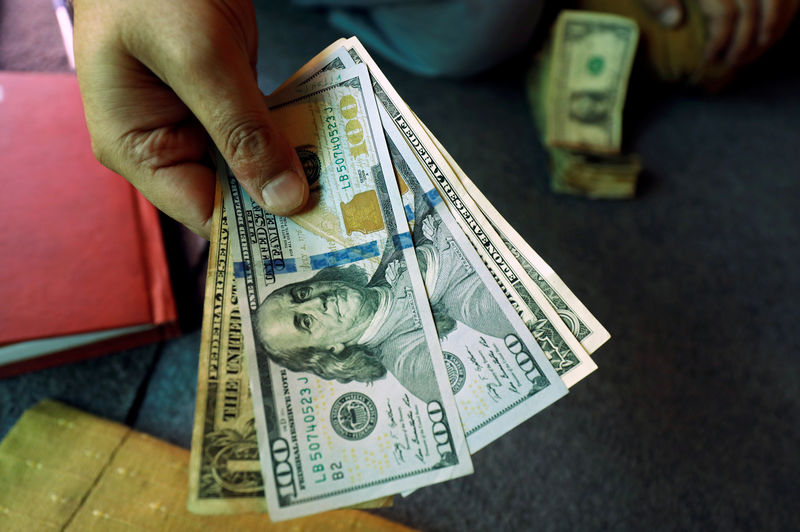(Bloomberg) -- For investors wondering how markets can keep rallying in the midst of economic disaster, just look to the weakening dollar.
Its descent to a three-month low is adding a pillar of support to the bullish foundations powering risk assets across the globe this week. Emerging markets, commodities and equities have surged as money managers look beyond unemployment headlines, and focus on central bank stimulus and business reopenings.
While the greenback’s decline is one sign that risk appetite is rising, it’s also adding extra fuel to the fire. A lower U.S. currency makes American goods cheaper overseas, helping companies boost earnings.
It also eases financial strain among emerging-market countries by allowing them to repay dollar-denominated debt more easily, and boost hard commodities like gold, copper and oil that are priced in the currency. Plus, there’s an added boost to inflation expectations, which benefits stocks most likely to profit from a stronger economy.
In the past month, the dollar weakened against all but two major currencies. The Bloomberg Dollar Spot Index slid 0.2% on Thursday, extending an almost 7% retreat from a recent high on March 23. The MSCI Emerging Markets Index jumped 30% and copper gained 19% in that time.
The Dollar Is in a Funk and That’s a Good Sign for the Economy
“The falling dollar is a big deal as it eases financial conditions,” said Mark Nash, the head of fixed income at Merian Global Investors in London. “Fiscal stimulus, balance sheet growth of banks and the Fed are a good part of solving the problems we had before, which was not enough lending and dollar strength globally.”
The dollar’s decisive retreat signals that the global liquidation rout for the history books in the depths of the March madness is now over. That’s a risk-on signal for Wall Street banks recommending international trades to clients including high yield and emerging-market debt around the world. The premium investors demand for holding 10-year Italian bonds over benchmark German debt has come down by 88 points from this year’s peak in March.
Carry traders that thrive on a weak dollar to buy higher-yielding emerging-market currencies are also on a high. A Bloomberg currency index that measures carry-trade returns from eight developing nations, funded by short positions in the greenback, posted its first positive month this year in May.
“It is usually the case that when the dollar is not soaking up liquidity i.e. rising, there is room for credit to perform,” said Luke Hickmore, who oversees about $3 billion as investment director at Aberdeen Standard Investments in Edinburgh.
Hickmore is turning to riskier assets such as credit, though he acknowledges that the rally is largely running on central bank stimulus. There’s a good chance that worries about corporate health will come back into the picture later this year, and bring a wave of ratings downgrades.
“I have been very skeptical to say the least about a broad risk-on move. However, the high frequency economic data is improving and we are still getting massive fiscal and central bank buying,” Hickmore said. “It is, on balance, time to be risk-on, but maybe not up to the max budget.”
Tug-of-War Between Bulls and Bears Is Muddling Risk Signals
There’s also skepticism that the dollar’s weakness will last, especially in the middle of a recession. Bank of America (NYSE:BAC) Merrill Lynch’s Athanasios Vamvakidis, the head of G-10 FX strategy, says the team is expecting a 4.3% drop in global economic growth, deeper than the consensus view for a 3% contraction.
“Investors expect a recovery of the global economy after the lockdown,” he said. “The recovery is going to be very weak, as economies cannot really go back to normal.”
Jack McIntyre, a portfolio manager at Brandywine Global Investment Management, is more optimistic. He’s buying up higher risk assets and currencies to take advantage of the “backstop” from the Federal Reserve, and pointed to the violent U.S. protests as part of the reason behind the dollar’s poor performance.
“When I looked at the riots and the way the U.S. is handling the coronavirus pandemic, I thought, ‘Oh my God, we are coming apart at the seam,’” McIntyre said in an interview. “Maybe the U.S. is losing some of its exceptionalism. The dollar has been overvalued for a long time, and this might finally be a catalyst for the dollar to weaken.”
(Updates with dollar move in fifth paragraph.)
©2020 Bloomberg L.P.
